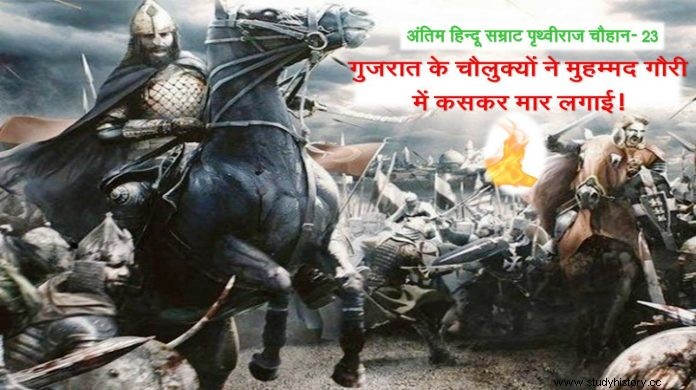
In the twelfth century AD, a new dynasty emerged in the city of Ghazni in Afghanistan called the Gaur dynasty. The hill region of Gaur is situated between Ghazni and Herat. The residents of Gaur region are called Gauri. In AD 1173 Ghiyasuddin Ghori permanently took over Ghazni and appointed his younger brother Shahabuddin Ghori as its ruler. This Shahabuddin came to be known as Muhammad Ghori in India.
In the period from AD 1175 to AD 1206, Muhammad Ghori, like Mahmud Ghaznavi, made many attacks on India and trampled the entire north-western India. Modern Indian historians have given several motives for the invasions of India by Muhammad Ghori. Historians believe that Muhammad Ghori wanted to destroy the nobles of Mahmud Ghaznavi's dynasty ruling in different regions of Punjab so that there would be no threat to Muhammad Ghori's empire in future.
Some historians believe that Muhammad Ghori wanted to immortalize his name in history by establishing a Muslim empire in India. He wanted to get the immense wealth of India. According to many historians, Muhammad Ghori was a staunch Muslim, so he considered it his ultimate duty to eliminate paganism i.e. idol worship from India.
Thus there was no single reason for Muhammad Ghori to attack India. The political, cultural and economic reasons behind his attacks were very clear. That's why Muhammad Ghori was engaged in the fulfillment of these objectives for 30 years of his life.
Many historians say that Muhammad Ghori laid the foundation of Muslim power in India, but the reality is that small Muslim rulers were ruling in Sindh, Multan, Punjab and Nagaur etc. .
Watch this interesting history video-
At the time when Muhammad Ghori first invaded India, four major Hindu kings were ruling in North India. The first of these was King Prithviraj of the Chauhan kingdom of Delhi and Ajmer, the second was Raja Jaichand of the Gahadwal kingdom of Kannauj, the third was King Govindpal of the Pala dynasty of Bihar and Lakshman Sen of the Sen dynasty in Bengal.
All these states were divided among themselves and they were engaged in mutual conflicts. The enmity between Prithviraj and Jaichand was at its peak. Both the kings never let go of any opportunity to humiliate each other. South India was also badly scattered. Gujarat was ruled by the Chaulukyas, the Yadavas in Devagiri, the Kakatiyas in Warangal, the Hoysalas in Dwarasamudra and the Pandya dynasty in Madura. They were also carrying out their genetic tradition by destroying each other by fighting each other.
Socially also the condition of India was very deplorable. In the absence of proper political patronage and proper spiritual guidance, the moral degradation of the society had taken place. The entire burden of war and defense of the country from the enemy was on the Rajput caste. The rest of the people were indifferent to this. The rulers were being eaten by the mite of luxury. National enthusiasm was completely lost. Some rulers had the zeal to die for the country and religion, but they were victims of mutual division. The social condition of women had fallen considerably in comparison to the later Vedic period.
Although Mahmud of Ghaznavi was successful in plundering India's economic wealth on a large scale, but due to the advanced stage of agriculture, industry and trade, India was again able to recover. The dynasties had become rich again and the life of the people was happy and prosperous despite being simple.
At this time Indian society was dominated by Shaivism and Vaishnava sects of Hinduism and Buddhism was almost destroyed. Jainism was alive in the deserts of South India and the West. Islam had spread in Sindh, Multan and Punjab.
Thus, the political, social, economic and religious conditions of the country were not such on which India could face a dreadful invader like Muhammad Ghori. Therefore, it was not a difficult task for a small robber like Muhammad Ghori, who lived from a small village like Gaur, to sneak into India from a poor state like Ghazni.
Muhammad Ghori's first invasion of India took place on Multan in AD 1175. Multan was then ruled by Shia Muslim Karmathis. Muhammad Ghori defeated them and captured Multan. In the same year, Ghori invaded the Kutch region of Upper Sindh and took it under his control. Since it was considered a mutual matter of Muslims, no importance was given to this attack by the Hindu kings.
Muhammad Ghori's second invasion of India took place in AD 1178 on the Chaulukya kingdom of Gujarat, which used to be a wealthy state at that time. At this time, Mulraj (II) was ruling Gujarat. His capital was Anhilwara. Gauri reached near Abu through Multan, Kutch and western Rajputana. There he fought with the army of Mulraj (II) near Kayadra village.
The Chauhan ruler Kanhaddev of Nadaul, the Chauhan ruler Kirtipal of Jalore and the Parmar ruler Dharavarsha of Abu also came to the aid of the Chaulukyas with their armies.
In this war many soldiers of Muhammad Ghori's army were killed and Muhammad Ghori was badly defeated. He fled to Afghanistan again through the desert, saving his life. This was his first struggle with the Hindu kings of India and he had tasted defeat in the very first struggle.
Since Muhammad Ghori was defeated and driven away by a Hindu king, other Hindu kings of India still did not consider Muhammad Ghori as a big problem and Indian Hindu kings were busy in their mutual battles.
Watch in the next episode- Muhammad Ghori entered India via Punjab!
-Doctor. Mohanlal Gupta
